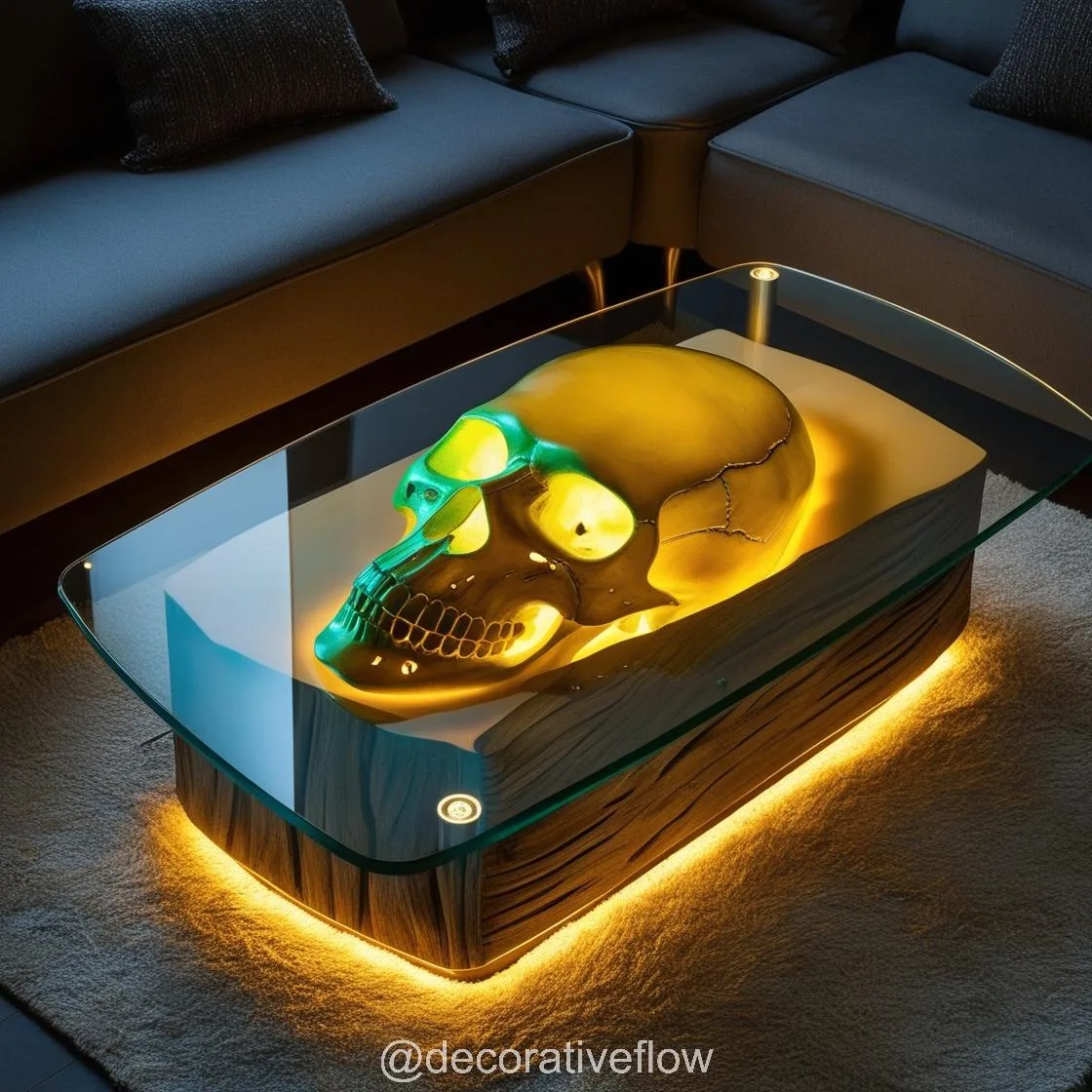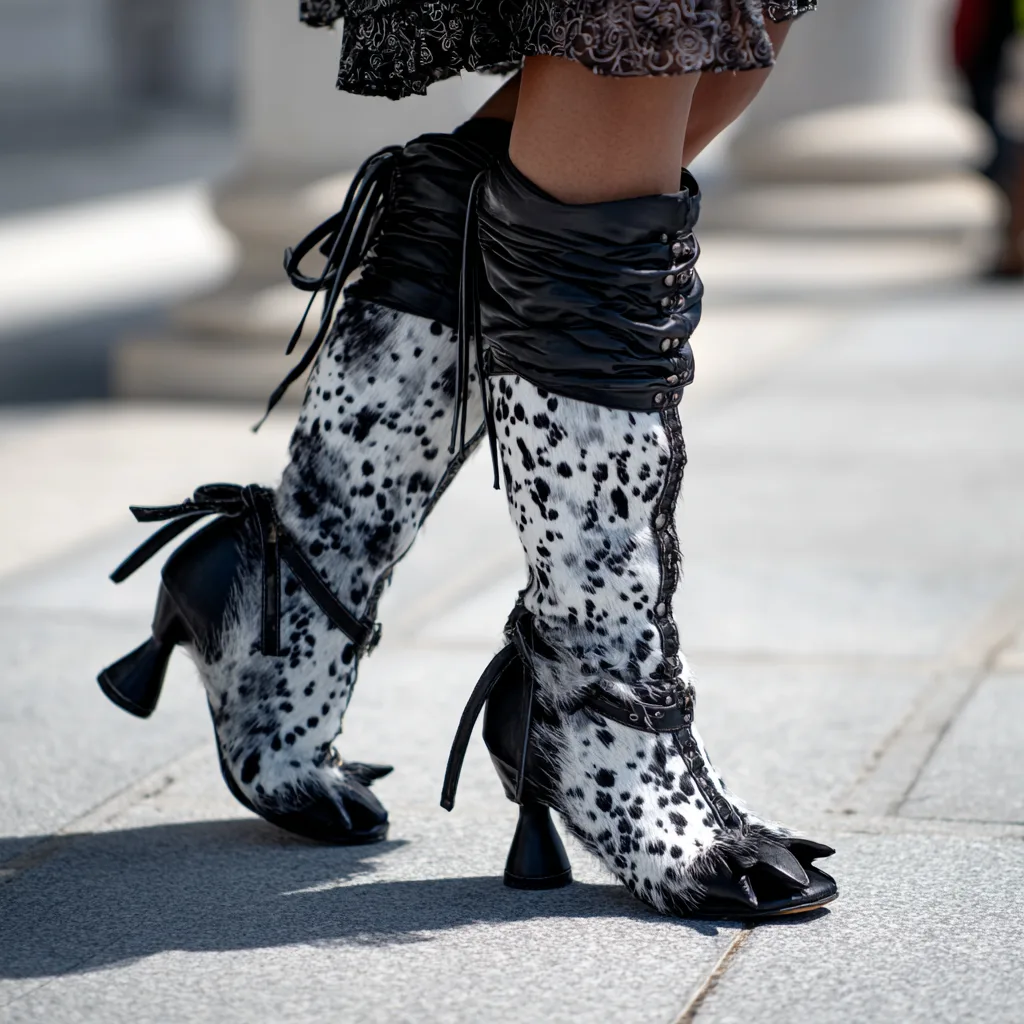The world of interior design is filled with creative expressions that bring personality and a unique edge to any space. Among these bold statements, one design stands out for its audacity and powerful aesthetic—Tables Skull Design. Far from just a piece of furniture, tables featuring skull motifs have become an iconic choice for those looking to add a sense of bold sophistication and gothic-inspired intrigue to their rooms. Skull-themed tables blend artistry and utility, evoking a unique balance of elegance, rebellion, and modern design.
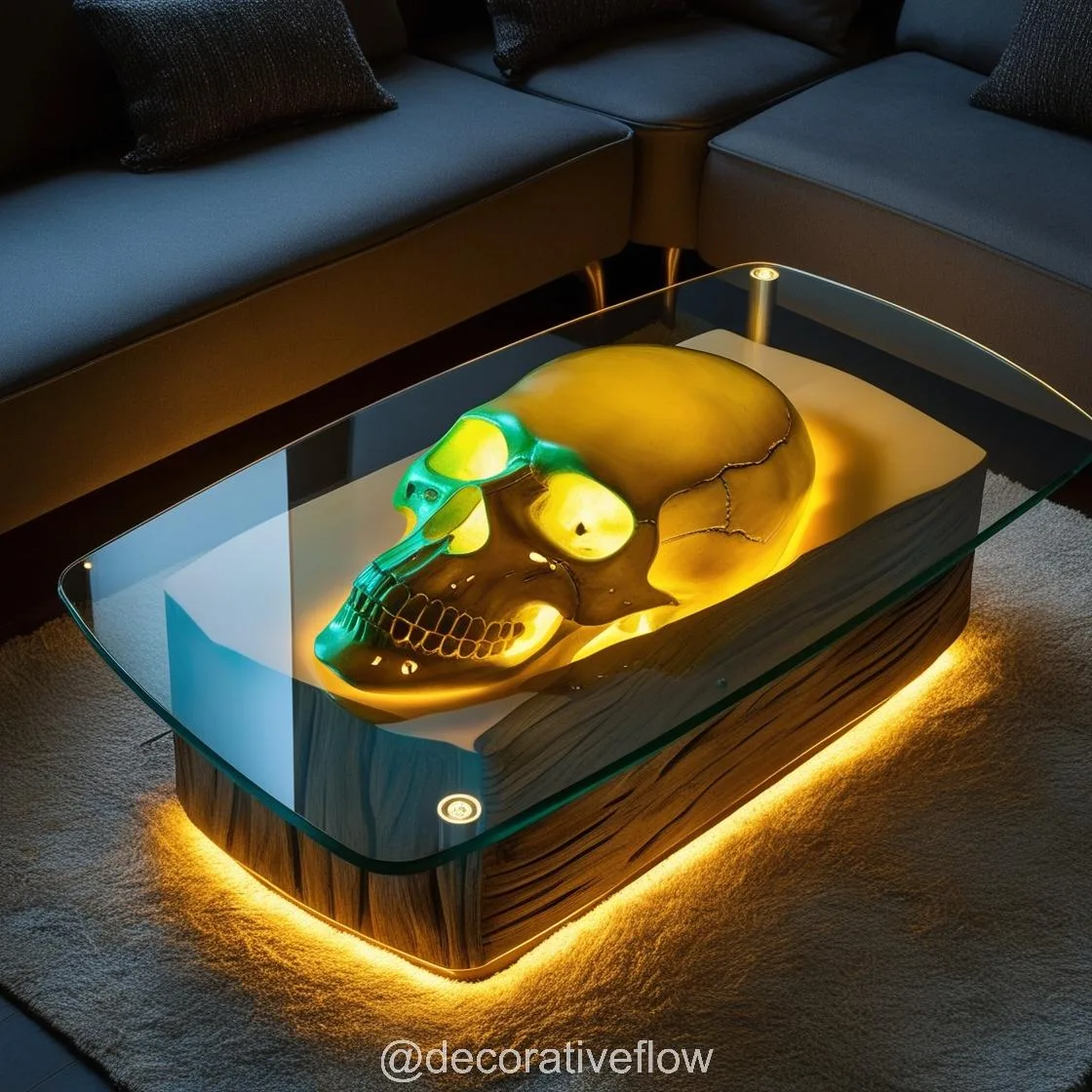
Embracing a Tables Skull Design isn’t simply about adding furniture to a room; it’s about creating a focal point that speaks volumes about your style, your interests, and your willingness to explore unconventional design elements. In this article, we’ll explore the evolution of skull designs in interior décor, delve into the various styles and materials available, and discover how a skull-themed table can redefine your space in a way that is both timeless and trend-setting.
Contents
- 0.1 1. The Symbolism and History Behind Skull Design in Décor
- 0.2 2. Different Styles of Tables Skull Design: From Minimalist to Gothic
- 0.3 3. Popular Materials in Skull Table Design: Merging Function with Aesthetics
- 0.4 4. Where to Place Your Skull Table: Room-by-Room Inspiration
- 0.5 5. Tips for Styling Your Skull Table: Achieving a Harmonious Look
- 0.6 6. Benefits of Adding a Tables Skull Design to Your Space
- 1 Conclusion
1. The Symbolism and History Behind Skull Design in Décor
Skull imagery has held symbolic significance across cultures and time. Historically, skulls have been seen as reminders of mortality, strength, and the cycle of life. In ancient cultures, skull motifs represented respect for ancestors and the spiritual world, while in more recent times, they have come to symbolize resilience, rebellious spirit, and even luxury. The fascination with skull imagery has inspired artists, fashion designers, and interior decorators to use skull motifs to add a compelling visual and philosophical dimension to their work.
For those who embrace skull design in furniture, the choice is often more than aesthetic. It represents a celebration of life, a nod to alternative culture, and a commitment to unique design. Skull-themed tables bridge the traditional with the modern, combining artistry with the raw symbolism of the skull, making them ideal for bold, sophisticated, and expressive interiors.
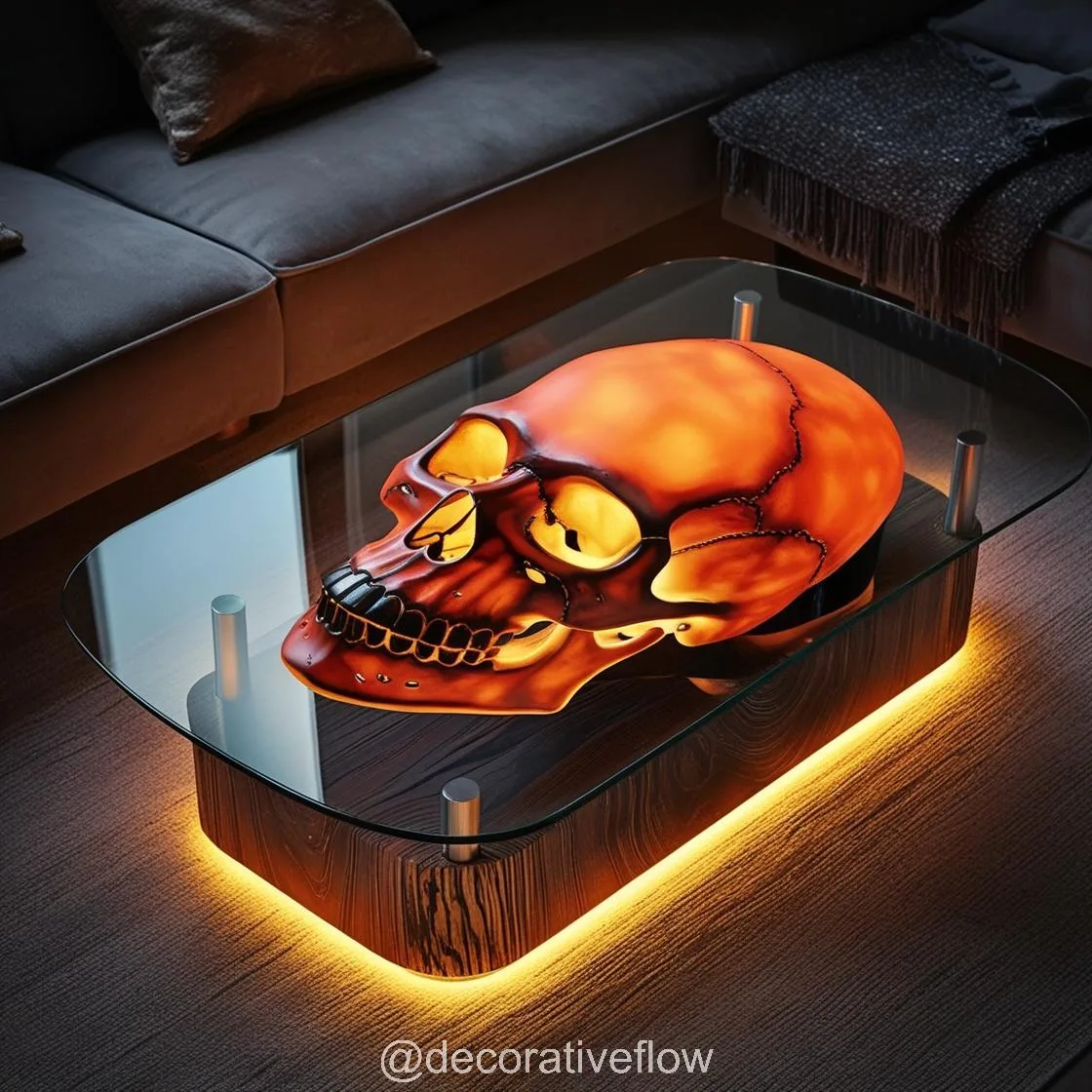
2. Different Styles of Tables Skull Design: From Minimalist to Gothic
Tables Skull Design can be found in a range of styles, from minimalist modern to dark and gothic. Depending on the look and feel you desire, there are numerous options to consider:
- Modern and Minimalist: Skull tables with sleek lines and neutral colors often use subtle skull shapes or outlines, giving a modern touch. These designs focus on blending the skull motif into the table’s structure without overwhelming the overall aesthetic. Materials such as glass, metal, and polished wood are common in minimalist skull tables, offering a contemporary look that feels bold yet understated.
- Gothic and Antique-Inspired: For those who embrace a more dramatic style, gothic skull tables are crafted with intricate details. They may feature ornate engravings, dark wood finishes, and distressed metal for an antique feel. These tables are inspired by Victorian and gothic styles and bring a sense of grandeur and mystery to a space, creating an ambience perfect for reading rooms, study areas, or spaces with rich, dark color palettes.
- Industrial and Rustic: Skull tables with a rustic twist combine elements like weathered wood, exposed metal, and raw finishes, giving them an industrial charm. These pieces pair well with urban or loft-style interiors and provide a unique contrast of warmth and edge. For fans of vintage or repurposed furniture, rustic skull tables feel authentic, like a treasure with its own story.
- Pop-Art and Contemporary: This style embraces vibrant colors and exaggerated forms, inspired by pop-art aesthetics. Pop-art skull tables can be vibrant, playful, and eye-catching, often becoming a conversation starter. Bright colors, glossy finishes, and creative use of skull shapes make them a fitting choice for eclectic or modern homes.
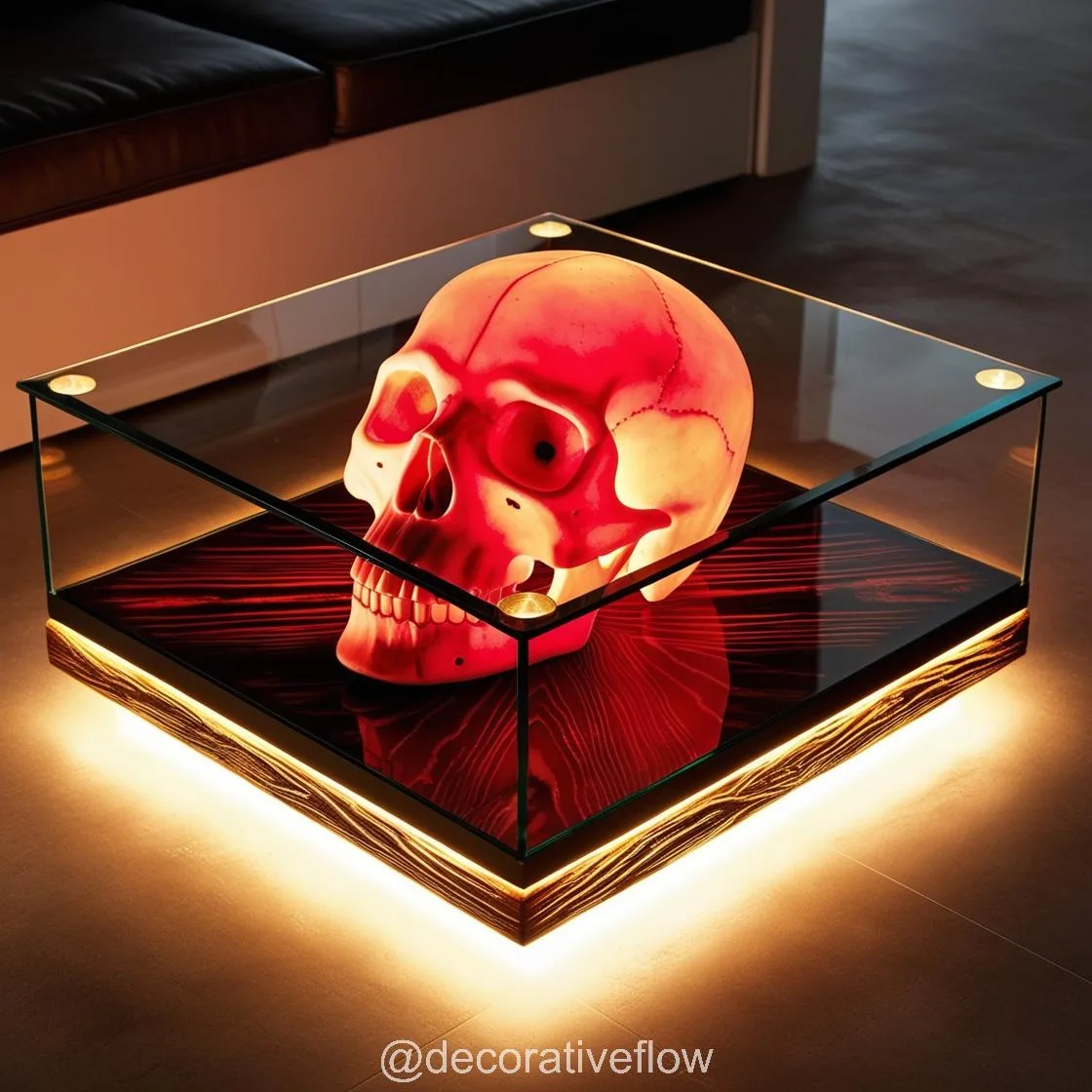
3. Popular Materials in Skull Table Design: Merging Function with Aesthetics
The materials used in skull tables greatly influence their overall look and feel. Here are some popular materials and how they impact the aesthetic and durability of skull tables:
- Metal: Tables Skull Design crafted from metal offer a sleek, durable option, often associated with a modern or industrial aesthetic. Metals like aluminum, steel, and iron can be shaped into bold skull forms, with details that add depth and texture. Metal skull tables are also practical in high-traffic areas due to their strength and resilience.
- Glass and Acrylic: Glass skull tables often combine transparency with detailed etching or embedded skull designs. These tables are perfect for minimalist or modern interiors, as they create a sleek and unobtrusive look while still adding a hint of intrigue. Acrylic skull tables offer a similar transparent effect but are more versatile and impact-resistant.
- Wood: Wooden skull tables are a favorite for those who prefer a more natural, rustic aesthetic. Oak, mahogany, and walnut are common choices for the organic warmth they bring to the skull motif. Carving skull shapes or incorporating skull details into wooden tables adds a timeless charm and showcases artisan craftsmanship.
- Stone and Marble: Marble and stone skull tables bring a luxurious feel to any space, exuding sophistication and durability. The natural veining of marble adds a unique visual texture to the skull shape, while other stones like granite add heft and grandeur. These tables are ideal for elegant and high-end interiors where the skull design can stand as a true work of art.
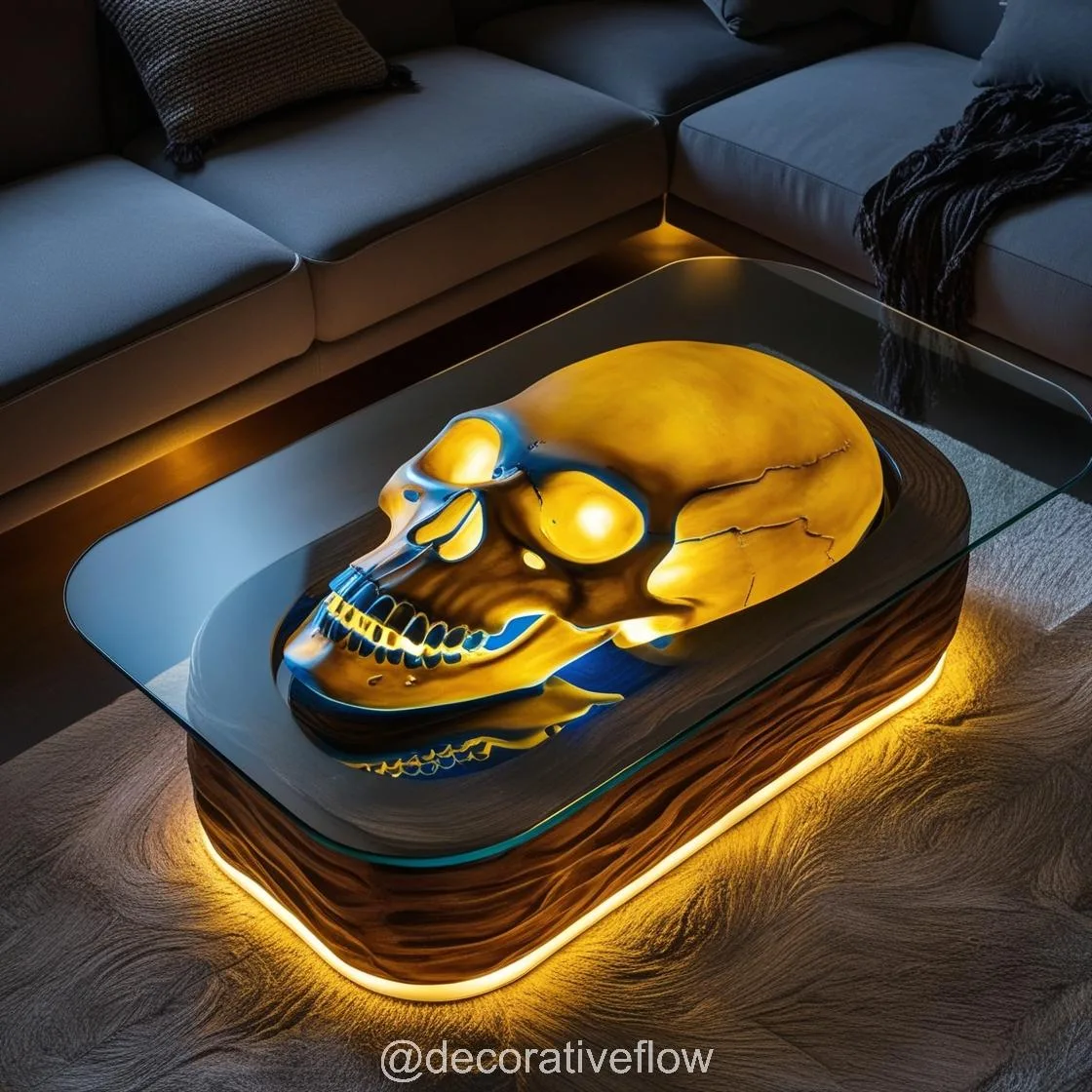
4. Where to Place Your Skull Table: Room-by-Room Inspiration
A Tables Skull Design can adapt to various spaces in your home, from living rooms to bedrooms. Here are some ideas on where and how to place a skull table to enhance your space:
- Living Room Statement Piece: In the living room, a skull table can serve as a central coffee table or side table, anchoring the room’s aesthetic. Paired with neutral or dark-toned furniture, it becomes the focal point, adding an element of surprise and depth. Consider adding a few small accent pieces, like candles or antique books, to enhance its gothic or modern vibe.
- Bedroom Nightstand: Placing a skull table as a nightstand adds a touch of intrigue to your personal space. It could be a small skull-themed table next to the bed, subtly adding personality without overwhelming the room’s decor. This option is ideal for those who want to introduce the skull motif in a subtle and intimate way.
- Home Office or Study Area: A skull table in the home office brings a blend of sophistication and edge, inspiring creativity and confidence. For a study area, a skull-themed desk can become the centerpiece, enhancing the room’s atmosphere with a gothic or modern edge. Dark wooden skull tables or industrial-style metal ones fit particularly well in these settings.
- Outdoor Patio or Lounge Area: Skull tables designed for outdoor use can add a touch of mystique to patios or lounge areas. Durable materials like metal or treated wood can withstand the elements, and the skull design brings an unexpected element of style to your outdoor space, especially when paired with moody lighting or rustic seating.
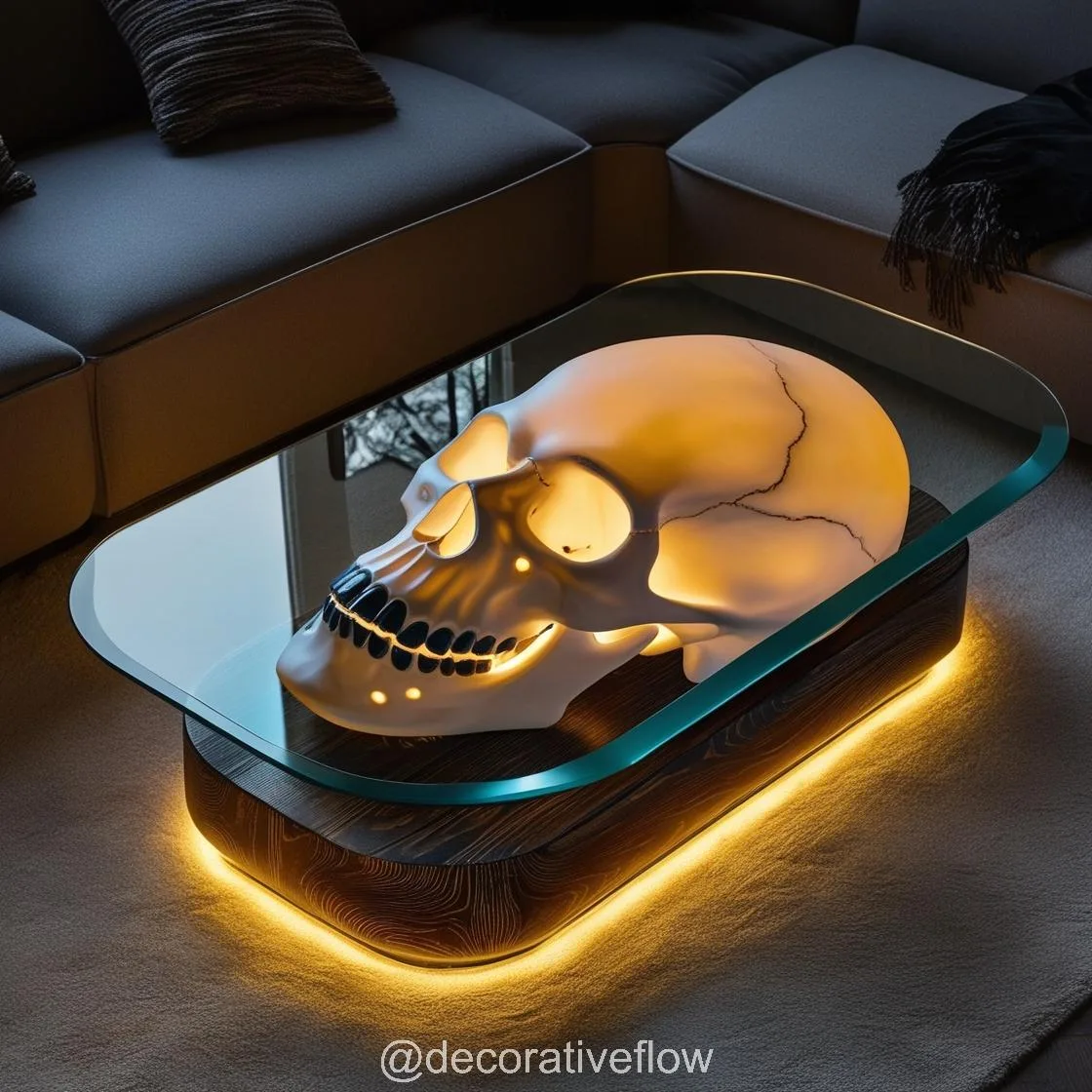
5. Tips for Styling Your Skull Table: Achieving a Harmonious Look
Styling a bold table with skull motifs can be a challenge, but a few tips can help you seamlessly incorporate it into your space:
- Choose Complementary Colors: Skull tables often work well with dark, neutral, or earthy tones. Black, charcoal, dark green, and burgundy create a balanced and cohesive look. However, a pop of color can be added through accents like cushions or rugs to create contrast and interest.
- Balance with Texture: Since skull tables can be visually heavy, balancing them with softer textures can create a harmonious look. Soft fabrics, plush seating, and neutral-colored accessories work well in balancing the room and keeping it from feeling too intense.
- Mix and Match Styles: A Tables Skull Design can pair beautifully with both vintage and modern elements, adding to the eclectic feel of a room. Mixing classic elements like leather seating or chandeliers with a skull table can create a sophisticated yet edgy look that’s full of character.
- Consider Accent Lighting: Lighting can transform the appearance of your skull table, adding depth and drama. Wall sconces, chandeliers, or small candles placed around the table can enhance its details, casting intriguing shadows and making it a standout piece.
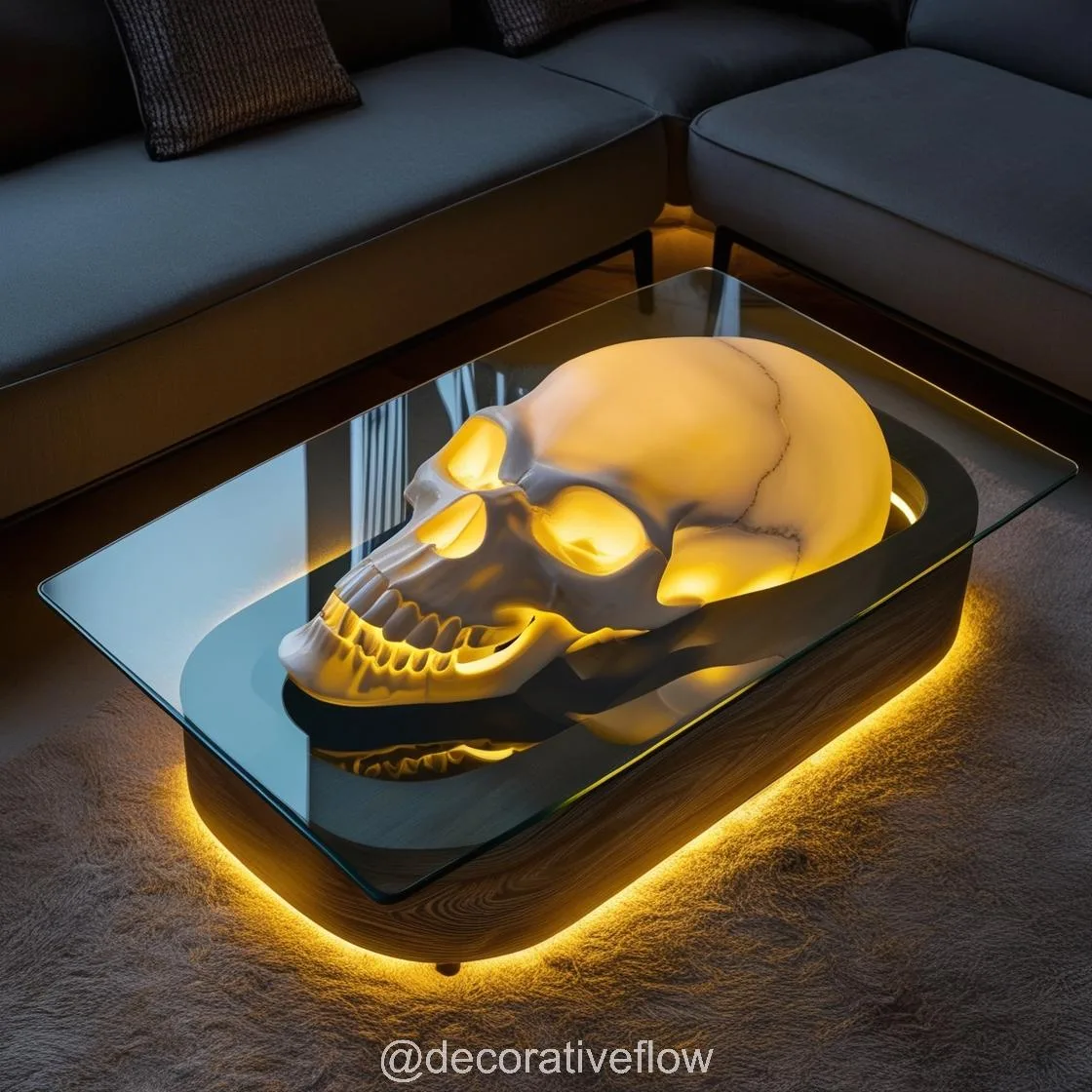
6. Benefits of Adding a Tables Skull Design to Your Space
Choosing a Tables Skull Design offers more than aesthetic appeal—it adds layers of meaning and intrigue to your space. Here are a few unique benefits:
- Unique Personal Expression: Skull tables are rare and unique, reflecting a taste for bold designs. Choosing one is a form of personal expression that communicates courage, individuality, and an appreciation for artistic symbolism.
- Conversation Starter: Skull tables have a captivating presence that encourages conversation. Whether you’re hosting friends or relaxing with family, these tables bring an interesting, distinctive vibe to any room, making them unforgettable for guests.
- Versatile and Timeless Appeal: The skull motif has been timelessly popular in art, design, and fashion, ensuring your table remains relevant and stylish for years. It’s a piece that you can continue to style in new ways as trends evolve.
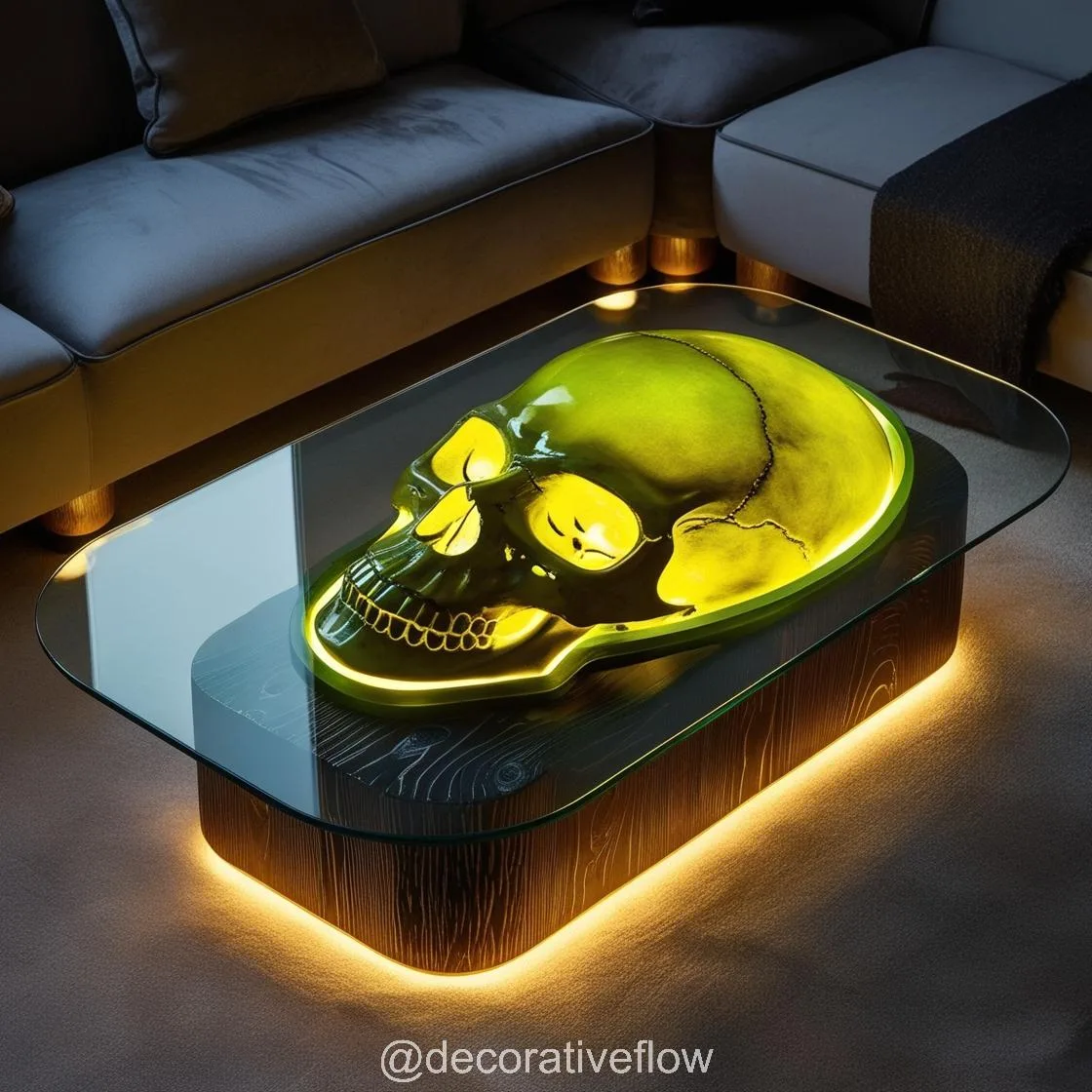
Conclusion
A Tables Skull Design is far more than a piece of furniture; it’s a powerful statement of individuality, taste, and artistic appreciation. From modern minimalist designs to gothic masterpieces, skull tables bring a unique flair to any room, instantly transforming the atmosphere and inviting admiration. By choosing a skull-themed table, you’re embracing a design that speaks to both tradition and modernity, infusing your space with a boldness that’s truly unparalleled.
Whether in the living room, bedroom, office, or outdoor space, a skull table is guaranteed to captivate and inspire. With its symbolic depth and striking visual appeal, a Tables Skull Design will remain a centerpiece in your home, representing resilience, style, and the courage to embrace bold designs. In the end, a skull table doesn’t just enhance your space—it transforms it, leaving a lasting impression that’s both beautiful and unforgettable.

